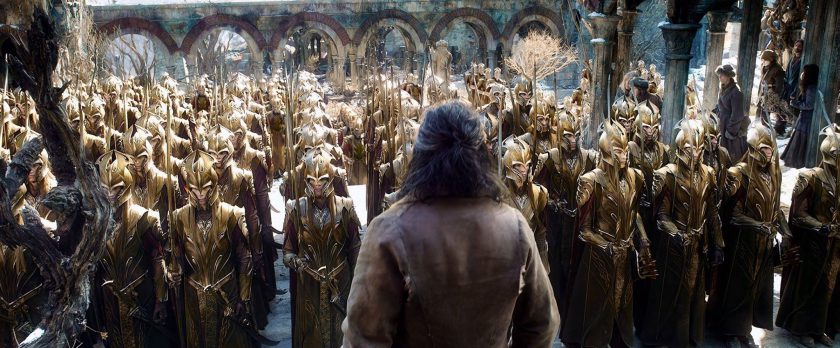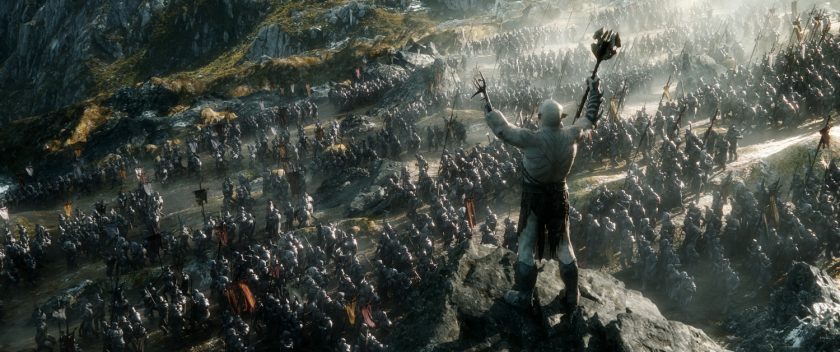
In his review of The Hobbit: The Battle of the Five Armies, David Bratman makes the astute observation that the title of the film goes unexplained. Unless the extended edition changes this when it’s released – presumably in November 2015 – viewers will have to decide for themselves which groups Peter Jackson considered one of the five armies.1
Tolkien, in contrast, makes it quite clear in the book (The Annotated Hobbit, ed. Douglas A. Anderson, p. 339):
So began a battle that none had expected; and it was called the Battle of Five Armies, and it was very terrible. Upon one side were the Goblins and the Wild Wolves, and upon the other were Elves and Men and Dwarves.
There we have it. The five armies refer to the Goblins, Wolves, Elves, Men and Dwarves. Case closed? Well, not quite.
What about the Eagles who turn the tide? Considering their appearance represents the great eucatastrophic moment of the battle surely they deserve to be counted amongst the five? Apparently not. And what of Beorn? Although he arrives alone at the last hour, he plays a key role in retrieving the injured Thorin and killing Bolg of the North.
Our other belligerents play less of a role in the battle, but don’t fit into any of the five groups. There’s Gandalf the Wizard and of course Bilbo the Hobbit. And we mustn’t forget the Bats (and the Ravens?) too.
The manuscripts published in John D. Rateliff’s The History of The Hobbit (2007) reveal that Tolkien’s conception for the ending of the story changed dramatically in the course of writing the book. Under his initial plan (see Plot Notes B, p. 366), the climactic battle of the story would not have involved dwarves at all, and would have taken place in – what we know as – the Anduin vale as Bilbo travels home from the Lonely Mountain after he (yes, Bilbo) killed Smaug. Here the Goblins and Wargs would have battled the Wood-elves, the Men of the woods and the south, and Beorn leading a host of bears.
Tolkien abandoned what Rateliff refers to as the ‘Battle of Anduin Vale’ and moved the climactic battle to the Lonely Mountain. This may have occurred when Tolkien jotted down Plot Notes F (p. 629) as this is the first time dwarves are mentioned as participants (and it is also where the name ‘Battle of Five Armies’ first appears):
1 2 3 4 5 woodelves Dwarves eagles men bears goblins wolves 6 7
These jottings suggest that at this point the five armies referred only to those groups fighting the forces of evil, and that there would be a combined total of seven armies. It was only in writing the final chapters that the tale familiar to us emerges (the Third Phase manuscript, p. 670):
So began the battle in a fashion none had expected. And it was called after the Battle of Five Armies, and it was very terrible. For upon one side were the Goblins and the Wolves and upon the other were men[,] elves and dwarves.
Personally I wish Beorn’s troop of bears had made it into the final story!
For more information see John D. Rateliff, The History of The Hobbit (2007), pp. 713-9. The book is a fascinating read as a whole and is highly recommended. A shorter version, focusing more on Tolkien’s manuscripts and less on Rateliff’s commentaries, will be published next month on 15 January as A Brief History of The Hobbit.
Note
- Although if the extended edition does identify the five armies at all, one would hope that it does so more tactfully than the 1977 Rankin/Bass adaptation of The Hobbit (where curiously the Eagles are identified as an army, while the Wolves are not).
UPDATE 28/12/2015: Although the extended edition itself did not clarify who the five armies were, a behind-the-scenes documentary did. According to “Beneath the Thunder: Forging a Battle of Five Armies” on The Appendices Part 12, the five armies refer to Men, Elves, Dwarves, the Orcs of Dol Guldur, and the Orcs of Mount Gundabad.
